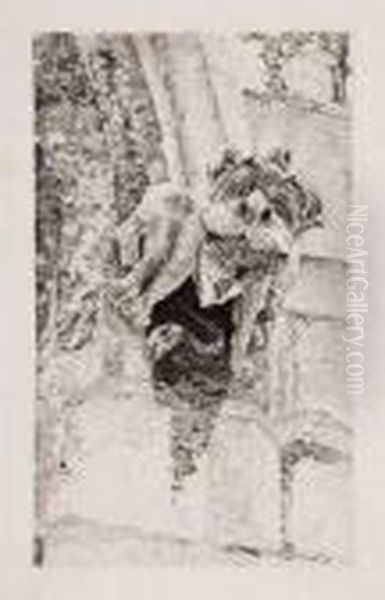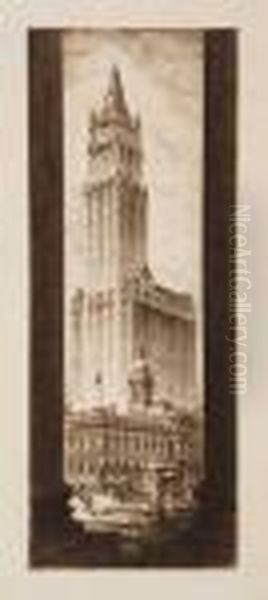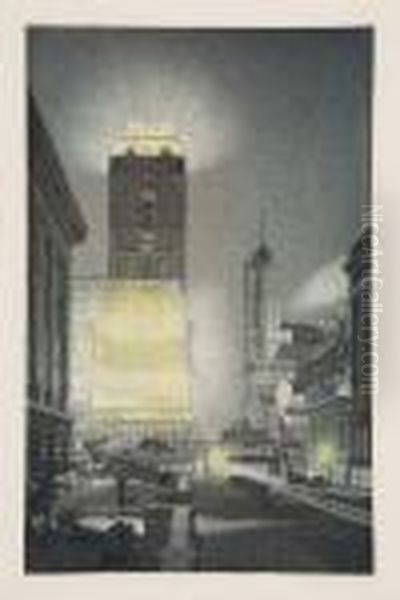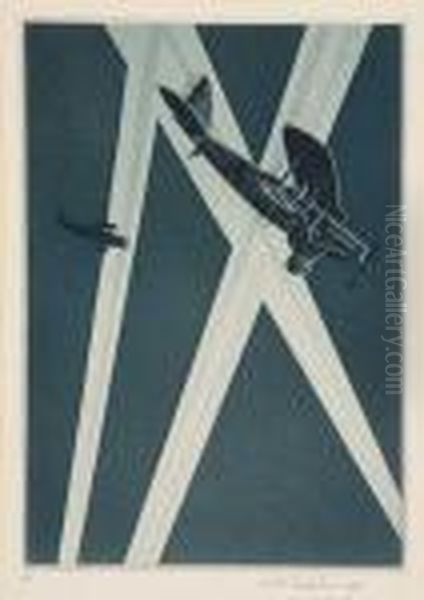John Taylor Arms stands as a towering figure in twentieth-century American printmaking. An artist whose initial training was in architecture, he translated his deep understanding of structural form and his profound admiration for historical styles into the demanding medium of etching. Renowned primarily for his extraordinarily detailed and evocative renderings of European Gothic architecture, Arms dedicated his life to capturing the spirit and intricate beauty of these stone monuments, believing them to be among humanity's greatest artistic and spiritual achievements. His technical virtuosity, combined with a romantic sensibility, secured his place as a leading etcher of his generation.
From Law to Architecture: An Unconventional Path
Born in Washington, D.C., in 1887, John Taylor Arms's journey into the art world was not direct. He initially pursued a legal education at Princeton University. However, the structured logic of law proved less compelling than the creative possibilities of design. After two years, he made a decisive shift, transferring to the Massachusetts Institute of Technology (MIT) to study architecture. This decision was pivotal, laying the foundation for his future artistic preoccupations.
At MIT, Arms immersed himself in the principles of design, structure, and architectural history. He excelled in his studies, earning a Master's degree in architecture in 1912. Following graduation, he entered the professional world, working for the esteemed architectural firm of Carrère and Hastings. This practical experience further honed his drafting skills and deepened his appreciation for the complexities of building design, knowledge that would prove invaluable in his later artistic endeavors.
A Christmas Gift and a New Vocation
While Arms was building a career in architecture, a serendipitous event steered him towards his ultimate calling. His wife, Noyes Dorothy Arms (née Dorothy Frothingham Noyes), herself an artist, played a crucial role in this transition. For Christmas in 1913, she presented him with a beginner's etching kit. Intrigued, Arms began experimenting with the tools and techniques. This gift proved to be transformative.

In 1914, he completed his first etching, titled Sunlight and Shadow. This initial foray into the medium sparked a passion that would soon eclipse his architectural ambitions. The process of incising lines into a copper plate, the controlled bite of the acid, and the magic of pulling a print resonated deeply with his meticulous nature and his draftsman's sensibility. The potential for fine detail and tonal richness offered by etching captivated him.
War, Travel, and the Gothic Muse
Arms's burgeoning interest in etching coincided with the outbreak of World War I. He served in the United States Navy from 1917 to 1919, holding the rank of Ensign and working as a navigation officer. This period of service took him to Europe, providing firsthand exposure to the continent's rich architectural heritage, particularly the magnificent Gothic cathedrals of France and England. Seeing these structures in person, understanding their scale, complexity, and historical resonance, profoundly impacted him.
The war experience solidified his artistic direction. Upon his return to civilian life in 1919, Arms made the significant decision to abandon his architectural career and devote himself entirely to printmaking. The Gothic cathedrals he had witnessed became his primary muse. He saw in their soaring vaults, intricate tracery, and sculptural decoration not just architectural marvels, but expressions of profound faith and human aspiration.
The Pursuit of Gothic Spirit
Arms embarked on numerous trips to Europe throughout the 1920s and 1930s, sketchbook and etching tools in hand. France, Italy, Spain, and England became his artistic hunting grounds. He meticulously studied and sketched cathedrals, churches, and medieval townscapes. He was particularly drawn to the great French Gothic cathedrals, such as those in Amiens, Rouen, Chartres, and Beauvais, but his scope extended to capturing the unique architectural character of various regions.
He believed that Gothic architecture represented "man's greatest expression of his upward reach." In an era grappling with modernity and the aftermath of war, Arms felt a mission to record these monuments. He saw his etchings not merely as depictions, but as a means of preserving and communicating the spiritual and aesthetic values embodied in these structures, hoping to inspire and elevate contemporary society through their beauty and historical weight.
Unrivaled Technical Mastery
John Taylor Arms is celebrated for his almost unbelievable technical skill as an etcher. His architectural training provided him with an innate understanding of perspective, structure, and detail, but his execution in the etching medium was extraordinary. He worked with painstaking precision, often employing tools not typically associated with etching, such as sewing needles, and using magnifying glasses to achieve the finest possible lines.

His process was laborious and time-consuming. It is reported that some of his more complex plates required over a thousand hours of meticulous work. This dedication allowed him to render the weathered texture of stone, the delicate complexity of stained-glass tracery, the play of light and shadow across facades, and the sheer verticality of Gothic structures with unparalleled fidelity. His prints are characterized by their clarity, intricate detail, and rich tonal range, achieved through carefully controlled etching and masterful printing.
Signature Works and Thematic Series
Arms's prolific career resulted in over four hundred printed images. Among his most celebrated works is Gothic Spirit (1922), an etching that encapsulates his reverence for the style, focusing on the intricate details of a cathedral's interior, likely inspired by Amiens. This print exemplifies his ability to convey both architectural accuracy and a sense of awe-inspiring atmosphere.
He often worked in series, documenting the architectural heritage of specific regions. His French Churches series, begun in the early 1920s, captures the grandeur and diversity of ecclesiastical architecture in France. Similarly, his Italian Towns and Cities series explored the distinct character of Italian medieval and Renaissance structures. These series demonstrate his systematic approach to documenting the buildings he so admired.
While European Gothic architecture remained his central theme, Arms did not limit himself exclusively to it. He produced striking images of American architecture, most notably An American Cathedral (The Woolworth Building) (1921). This print treats Cass Gilbert's neo-Gothic skyscraper with the same reverence and detailed attention he accorded medieval cathedrals, highlighting the continuity of architectural ambition.
His oeuvre also includes atmospheric cityscapes, such as West Forty-Second Street, Night (1922), which captures the dramatic energy of nocturnal New York City through masterful control of light and shadow. Furthermore, Arms occasionally turned his precise technique to natural subjects, as seen in Wasps (1920), an intricate study combining etching and aquatint, and later, more experimental landscapes like The Valley of the Savory (1934), depicting a scene in Wyoming with a slightly more stylized approach. Reflections at Finchingfield, England (1938) showcases his ability to capture the tranquil beauty of the English countryside with delicate precision.
Context within the Etching Revival
John Taylor Arms emerged during the later phase of the Etching Revival, a movement that began in the mid-nineteenth century and saw renewed interest in etching as a fine art medium. He drew inspiration from earlier masters of the revival, particularly James McNeill Whistler, whose atmospheric effects and suggestive use of line influenced many artists. Arms admired Whistler's ability to capture mood and light, though Arms's own style developed towards a much higher degree of detailed realism.

The tradition of architectural etching had significant precedents. The dramatic Roman views of Giovanni Battista Piranesi in the 18th century set a standard for depicting architectural grandeur, while the moody, often haunting etchings of Parisian architecture by Charles Meryon in the 19th century offered a more romantic and psychological approach. Arms's work, while distinct, exists within this lineage of artists captivated by the built environment.
In America, Arms was a contemporary of other prominent etchers. Joseph Pennell was a major figure known for his depictions of industrial scenes and cityscapes, including skyscrapers, sharing Arms's interest in monumental structures. Impressionist painters like Childe Hassam also produced significant bodies of work in etching. Artists like Frank W. Benson, known for his wildlife etchings, and Levon West and Kerr Eby, who sometimes depicted scenes related to war or dramatic landscapes, were part of the vibrant American printmaking scene in which Arms played a central role.
Influence and Collaborations
Arms's meticulous technique and dedication to traditional craftsmanship influenced subsequent generations of printmakers who valued precision and detail. His work stood somewhat apart from the rising tide of modernism that favored abstraction and looser forms, yet his commitment to his chosen style and subject matter earned him widespread respect.
He also showed an interest in other printmaking traditions. His work sometimes reflects an awareness of Japanese prints, particularly in composition and the handling of specific motifs. For instance, his approach in works like Wasps shows a decorative sensibility, and sources mention his attempt to emulate the color effects of artists like Utagawa Hiroshige within the monochrome medium of etching, showcasing a cross-cultural artistic curiosity.
His friendship with fellow etcher John W. Winkler, known for his lively depictions of San Francisco's Chinatown, is also noteworthy. Arms provided significant support to Winkler during periods of mental illness, demonstrating a personal commitment to his fellow artists beyond purely professional interactions. This highlights Arms's character and his role within the artistic community.
Leadership and Advocacy for Printmaking
Beyond his own artistic production, John Taylor Arms was a tireless advocate for the art of printmaking. He was deeply involved in several prominent artist organizations dedicated to the medium. He served as President of the Society of American Etchers for many years, guiding the organization and promoting the work of its members.

He was also an active member of the Print Makers Society of California and an honorary member of the Canadian Society of Painter-Etchers. Through his leadership roles, lectures, and writings, Arms worked to elevate the status of etching and other printmaking techniques, educate the public about the processes involved, and foster a supportive community for print artists. He authored articles and contributed to books on printmaking techniques, sharing his extensive knowledge and passion.
Later Years and Enduring Legacy
John Taylor Arms continued to work prolifically throughout his life, traveling and etching until shortly before his death in New York City in 1953. His dedication to his craft never wavered. He produced a remarkable body of work characterized by its consistency of vision and extraordinary technical refinement.
His etchings were widely acclaimed during his lifetime and collected by major institutions and private collectors. Today, his works are held in the permanent collections of prestigious museums worldwide, including the Metropolitan Museum of Art in New York, the National Gallery of Art in Washington D.C., the British Museum in London, and the Bibliothèque Nationale de France in Paris, among many others.
The legacy of John Taylor Arms rests on his unparalleled skill in rendering architectural detail through etching and his profound, almost spiritual devotion to Gothic architecture. He stands as a master technician who used his craft to celebrate historical beauty and convey a sense of wonder. While artistic tastes shifted towards modernism, Arms remained steadfast in his pursuit of representational accuracy and romantic atmosphere, creating a unique and enduring contribution to American art history. His prints continue to fascinate viewers with their intricate beauty and transport them to the soaring spaces of Europe's great cathedrals.
Conclusion: An Architect's Eye, An Etcher's Hand
John Taylor Arms carved a unique niche for himself in the art world. Bridging the disciplines of architecture and printmaking, he brought an architect's understanding of form and structure to the etcher's plate. His life's work was a sustained homage to the Gothic style, executed with a technical brilliance that remains astonishing. Through his hundreds of meticulously crafted etchings, he not only documented architectural masterpieces but also communicated his deep reverence for their spiritual and aesthetic power. As a master craftsman, a dedicated artist, and a passionate advocate for printmaking, John Taylor Arms left an indelible mark on twentieth-century American art.